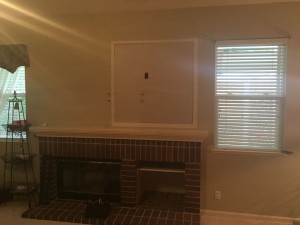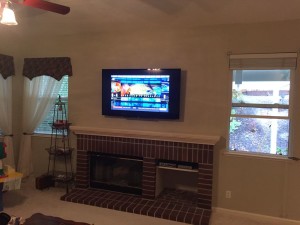Gone are the days when you plunked a new TV onto a console and plugged it in. While modern flat-screen TVs usually come with small stands, more homeowners prefer the flexibility of a set that’s mounted on a wall.
Hanging a TV is not a difficult job to do yourself, but there are some decisions you’ll need to consider:
1. First, before you buy your TV, make sure it will fit in your space.

Even if you aren’t restricted by a cabinet or the length of your wall, you do have to match your TV screen to the size of your room. If your space is small, a huge TV will overwhelm it and you won’t be able to sit far enough away to see it properly. Sitting too close means you’ll be moving your head from side to side and seeing pixels instead of a clear image.
Here are the general viewing distances for some standard TV screen sizes:
28-32 inches: 3.5 to 8 feet
36-40 inches: 4.5 to 10 feet
42-48 inches: 5.75 to 12 feet
50-54 inches: 6.25 to 13.5 feet
56-60 inches: 7 to 15 feet
2. Once you have your TV, choose the right mounting bracket.
Decide first what you want your TV to do. You can buy a simple fixed bracket, but you may prefer one that allows you to vary the set’s distance or angles for optimal viewing. If you expect to move your TV forward or side to side or tilt it, you’ll need to buy a bracket that can do those things.
Next, consider the weight of your TV, and make sure your bracket will support it. When checking weight limits, you want your TV to be near the bottom of the bracket’s range. For example, if you have a 48-inch TV, don’t buy a bracket that will hold a 30-48-inch TV; buy one that will support, say, a 40-65-inch TV. That gives you extra assurance your set will be firmly supported. Most TVs of the same size weigh about the same.
3. Consider the electrical source when determining where to place your TV.
You probably won’t have an electrical outlet in the middle of your wall just for your TV, but hanging your set directly above an outlet is almost as convenient. TVs today usually hook into components that require a lot of wire and cable connections, and you need a means to keep those out of sight and harm’s way. With the power source directly below the set, the wires can easily be run up through the wall to your TV without harming the sheetrock. It’s also possible to access power in the attic and string the cords down the wall.
If you don’t have a usable power source near your TV, you may need to install one. What you don’t want is a mess of cords dangling from your TV. Any electrical work should be done by a licensed contractor to ensure the safety of your home and family.
4. Install your set properly.
If your TV is to remain safely on your wall, the bracket must be attached to the studs. Most brackets have some sideways flexibility so you can attach it to the studs and still place it exactly where you want it. Use a stud finder to locate your studs – in California, they are 16 inches apart. In some cases, such as an extremely heavy TV or studs that aren’t strong enough to hold it, you may need to add cross studs – horizontal wood beams connecting the vertical studs. Be sure, also, that your fasteners are rated to support the weight of your TV. Again, choose a rating that puts your set’s weight at the lower end.
If you are mounting your TV into brick or concrete, such as over a fireplace, you’ll need to find fasteners made especially for these materials. In these situations, some of the other aspects of hanging your TV may be more complicated.

Watching movies on large home screens has become a favorite way of enjoying and entertaining family and friends, but the experience will only be a good one if your TV is the proper size and safely installed.
Call us if you need help mounting your TV. We guarantee your set will be perfectly installed.
